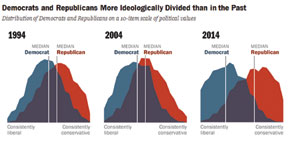 U.S. political views not rigidly defined
U.S. political views not rigidly defined
By Jazelle Hunt Washington Correspondent
WASHINGTON, D.C. (NNPA) – Politically, the nation is less sharply divided collection of red and blue states, and more a rainbow patchwork of political ideologies, according to the Pew Center.
The report, “Beyond vs. Blue: The Political Typology” (and its supplemental reports) breaks American politics down beyond primary colors. Political typology, a system the Pew Center devised 27 years ago, groups people based on their attitudes on key issues as opposed to their limited partisan labels.
“More Americans today hold consistently liberal or consistently conservative values across a wide range of issues, Democrats and Republicans are further apart ideologically, and more partisans express deeply negative views of the other political party,” the report reads. “But the typology shows that the center is hardly unified.”
This year’s typology survey revealed eight attitude categories. The highest share of African Americans (accounting for 30 percent of the group) fall into a category called the “faith and family left.”
Religion “is a very important part of life” for 85 percent of this group’s members. They are, or lean, Democrat, favoring robust social programs, while also holding conservative attitudes on moral and religious issues such as same-sex marriage, marijuana legalization, and abortion. For Republicans looking to draw Black voters from the left, this would be the fount—fully 37 percent of the faith and family left consider themselves conservative.
The faith and family left is the only category that is majority-minority—it also en-com-passes the largest share of Latino and foreign-born voters.
And yet, the views on racial issues are murky within this group. While 74 percent support affirmative action, only 28 percent believe the government should continue making changes to give Blacks equal rights. At the same time, 57 percent believe that “Blacks who are unable to get ahead are responsible for their own condition.”
According to the report, this is now the prevailing attitude in the United States.
“While the public is divided over whether additional societal changes are needed to further racial equality, most do not believe that discrimination is the main reason why many Blacks can’t get ahead today,” it states. “By more than two-to-one (63 percent to 27 percent), the public says Blacks who can’t get ahead are mostly responsible for their own condition.”
In fact, racial inequality is one of the most divisive topics on the left. Among “solid liberals” (just 15 percent of voters, 69 percent of whom are white), 80 percent say that discrimination holds Blacks back. This is compared to 31 percent of the faith and family left who believe the same. People under 50 who skew liberal are even more skeptical about racial inequality.
As the report explains, “The Next Generation Left is young, relatively affluent and very liberal on social issues like same-sex marriage and abortion. But they have reservations about the cost of social programs. And while most of the Next Generation Left supports affirmative action, they decisively reject the idea that racial discrimination is the main reason why many Blacks are unable to get ahead.”
Only 19 percent of members of this group attribute the African American plight to racial discrimination. Fully 67 percent believe that the U.S. has made enough changes to even the racial playing field, and 77 percent believe that anyone who wants to get ahead can do so through hard work. Black Americans account for 7 percent of the next generation left.
Black voters account for less than 5 percent of “steadfast conservatives” and even less of “business conservatives,” the two Republican-leaning groups. Among political “bystanders,” those disenfranchised or unregistered by choice and/or pay little to no attention to politics, 10 percent are Black. Black voters make up a significant share (20 percent) of “hard-pressed skeptics” who identify as Independents. (This group is still largely White, making up 61 percent of the ranks).
“Deeply financially-stressed and distrustful of government, Hard-Pressed Skeptics lean toward the Democratic Party but have reservations about both political parties,” the report explains. “They want government to do more to solve problems, but have doubts about its efficiency.”
This group has a half-hearted interest in following government (43 percent pay attention “most of the time”), is largely under- and unemployed, and has the lowest incomes and education levels.
In turn, members of this group overwhelmingly harbor negative opinions, including: immigrants are a burden on the country; government benefits don’t go far enough; hard work does not guarantee success; and the country’s best times have passed.
Despite all of these differences, the average citizen is not nearly as politically unyielding as the behavior of elected officials might suggest.
The report explains that “Overall, more Americans say they prefer elected officials who make compromises with people they disagree with than those who stick to their positions (56 percent vs. 39 percent),” with the exception of “steadfast conservatives” who prefer their candidates—well, steadfast. Similarly, the faith and family left are about evenly divided on the merit of candidates who can compromise.
And so, it’s going to be a nail-biting election season for a deadlocked two-party system struggling to capture and represent the ideological diversity among voters, the report concludes.
“Beyond the ideological wings, which make up a minority of the public, the political landscape includes a center that is large and diverse, unified by frustration with politics and little else,” it explains. “As a result, both parties face formidable challenges in reaching beyond their bases to appeal to the middle of the electorate and build sustainable coalitions.”
